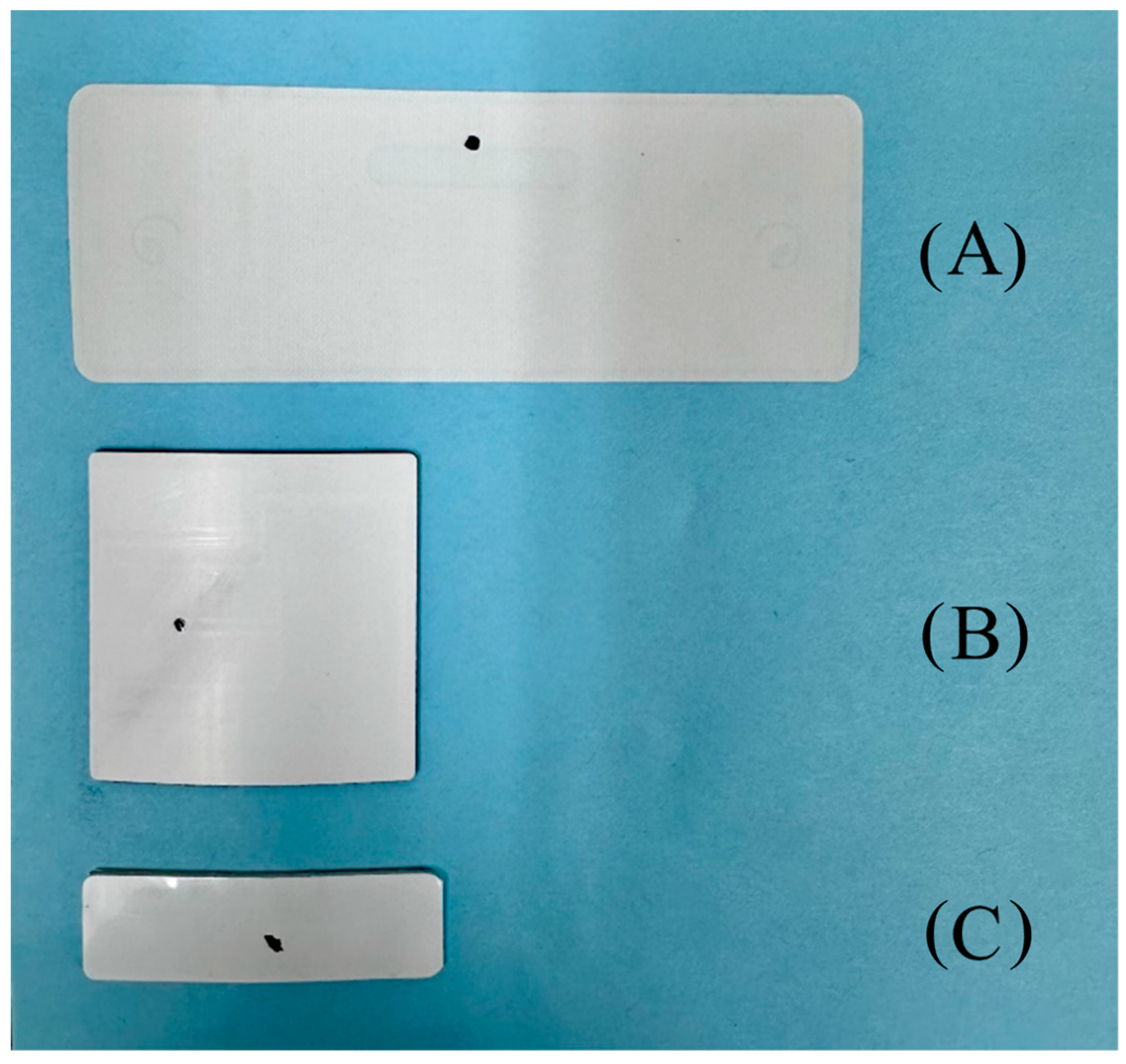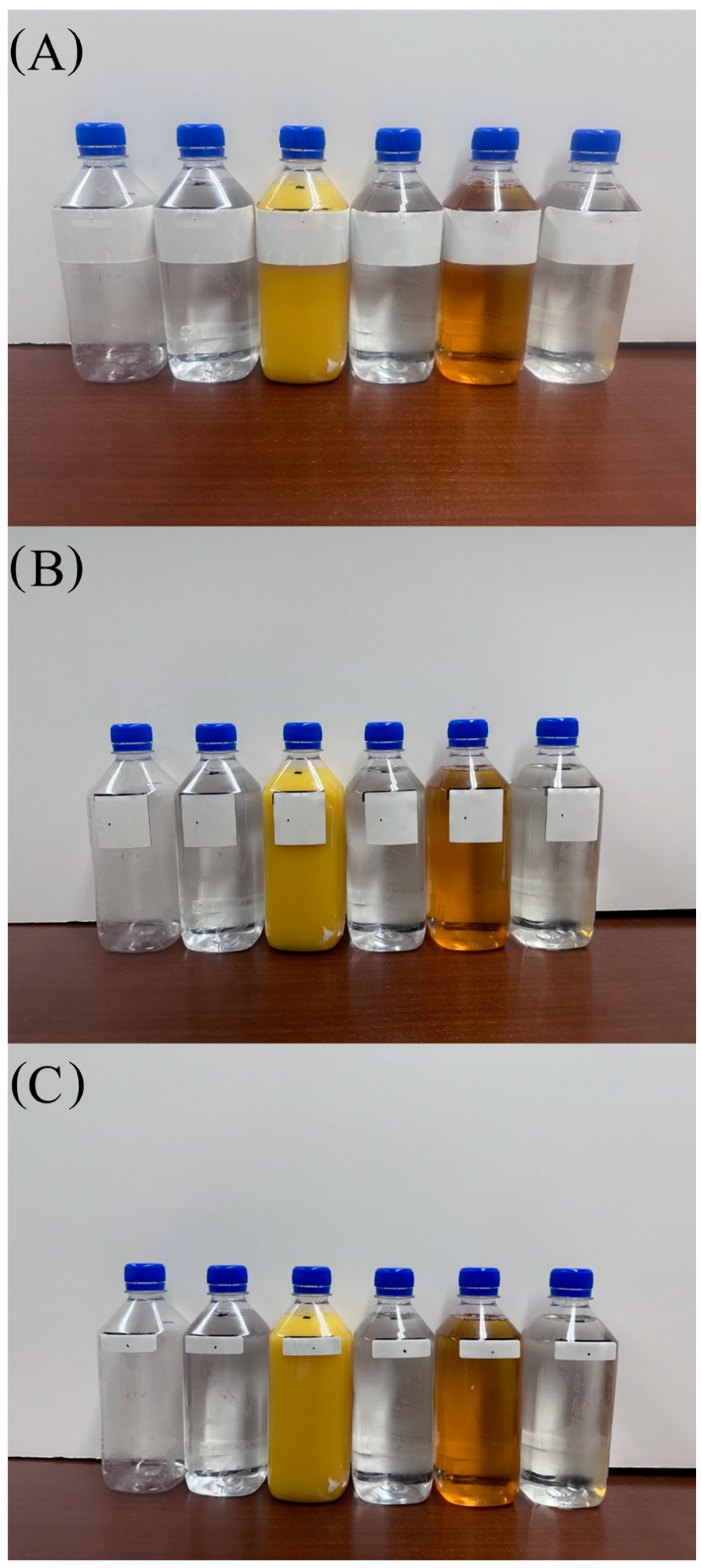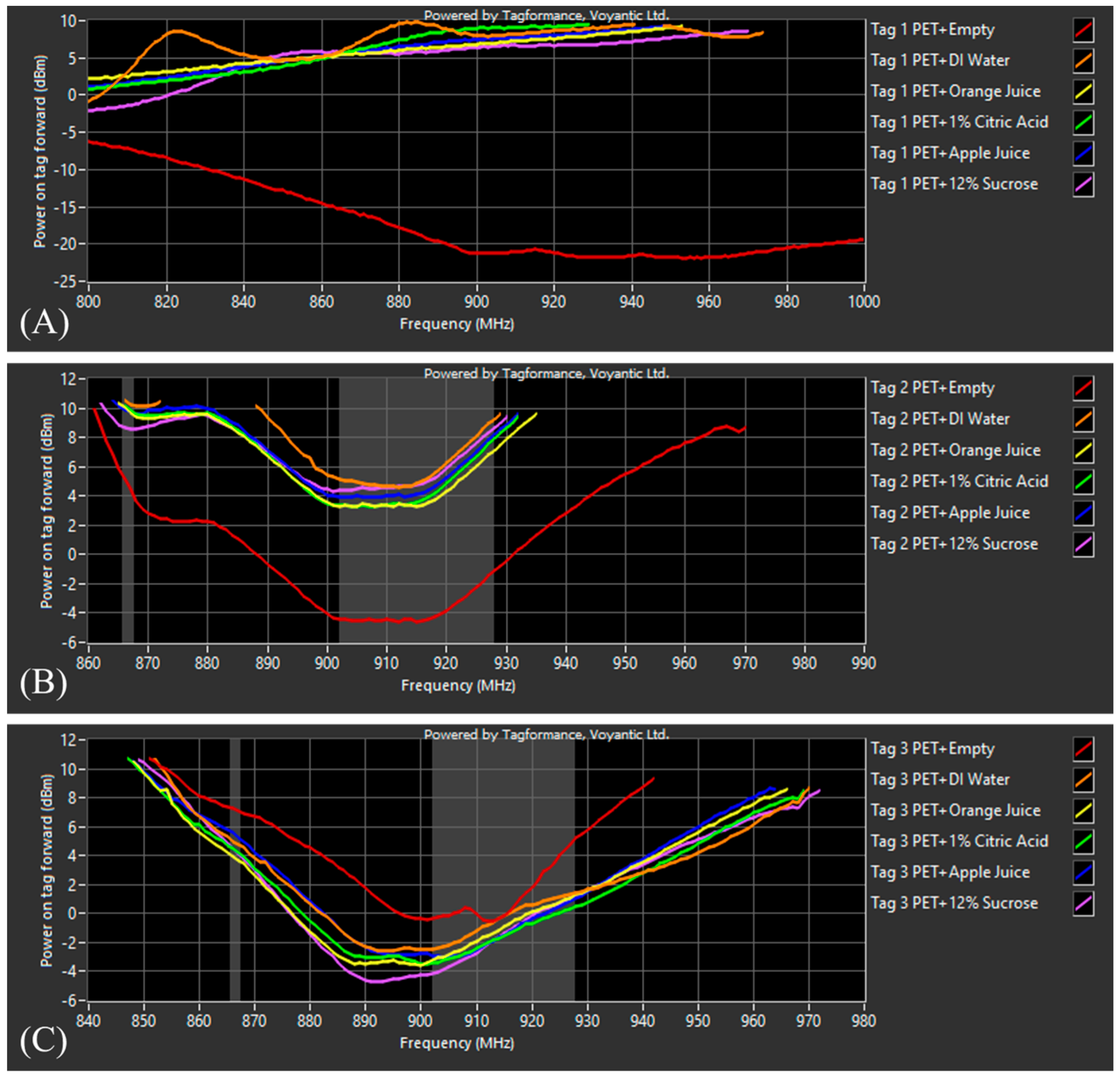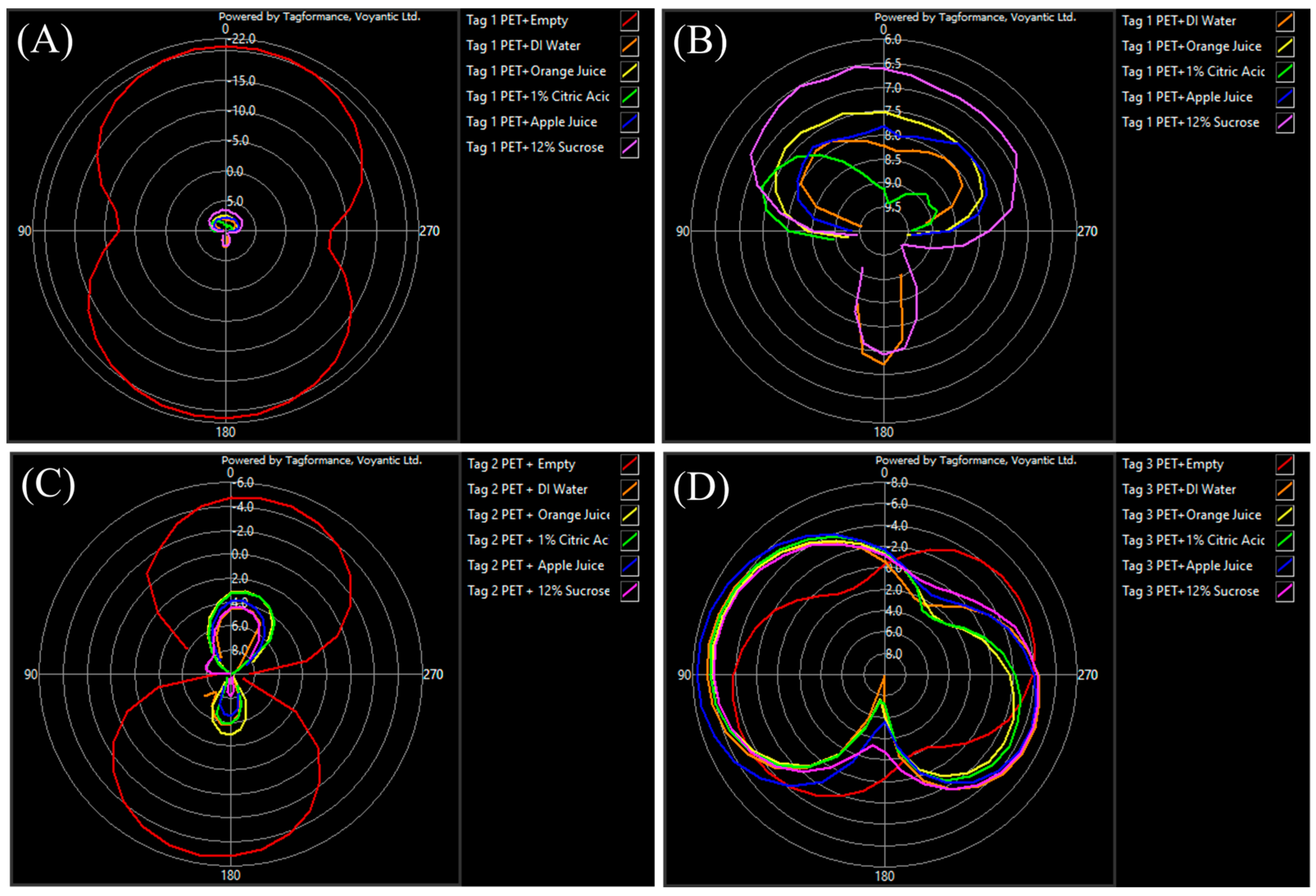Effect of Beverage Composition on Radio Frequency Identification (RFID) Performance Using Polyethylene Terephthalate (PET) Bottles for Smart Food Packaging Applications
Abstract
1. Introduction
2. Materials and Methods
2.1. Materials, Reagents, and Solutions
2.2. RFID Performance Testing Methodology and Parameters
2.3. Statistical Analyses
3. Results
3.1. Effect of Aqueous Solutions and Beverages on Tag Sensitivity and Backscatter
3.2. Effect of Aqueous Solutions and Beverages on Theoretical Read Range
3.3. Effect of Aqueous Solutions and Beverages on Radiation Pattern
4. Discussion
5. Conclusions
Author Contributions
Funding
Data Availability Statement
Acknowledgments
Conflicts of Interest
References
- An act to amend the Federal Food, Drug, and Cosmetic Act with respect to the safety of the food supply. In Public Law 111-353, 1st ed.; United States Statutes at Large; Office of the Federal Register: Washington, DC, USA, 2010; Volume 124, 124 Stat.3885.
- Bø, E.; Hovi, I.B.; Pinchasik, D.R. COVID-19 disruptions and Norwegian food and pharmaceutical supply chains: Insights into supply chain risk management, resilience, and reliability. Sustain. Futures 2023, 5, 100102. [Google Scholar] [CrossRef]
- López-Gómez, A.; Cerdán-Cartagena, F.; Suardíaz-Muro, J.; Boluda-Aguilar, M.; Hernández-Hernández, M.E.; López-Serrano, M.A.; López-Coronado, J. Radiofrequency Identification and Surface Acoustic Wave Technologies for Developing the Food Intelligent Packaging Concept. Food Eng. Rev. 2014, 7, 11–32. [Google Scholar] [CrossRef]
- Song, C.; Wu, Z.; Gray, J.; Meng, Z. An RFID-Powered Multisensing Fusion Industrial IoT System for Food Quality Assessment and Sensing. IEEE Trans. Ind. Inform. 2024, 20, 337–348. [Google Scholar] [CrossRef]
- Aniruddha Prabhu, B.P.; Dani, R.; Abdullah, K.H.; Sharma, T.; Bhatt, C.; Chauhan, R. A Comprehensive Review of Sensor-Based Smart Packaging Technology. Lect. Notes Electr. Eng. 2024, 1097, 39–52. [Google Scholar] [CrossRef]
- Crippa, M.; Solazzo, E.; Guizzardi, D.; Monforti-Ferrario, F.; Tubiello, F.N.; Leip, A. Food systems are responsible for a third of global anthropogenic GHG emissions. Nat. Food 2021, 2, 198–209. [Google Scholar] [CrossRef]
- Luo, N.; Olsen, T.; Liu, Y.; Zhang, A. Reducing food loss and waste in supply chain operations. Transp. Res. Part E Logist. Transp. Rev. 2022, 162, 102730. [Google Scholar] [CrossRef]
- Kharola, S.; Ram, M.; Kumar Mangla, S.; Goyal, N.; Nautiyal, O.P.; Pant, D.; Kazancoglu, Y. Exploring the green waste management problem in food supply chains: A circular economy context. J. Clean. Prod. 2022, 351, 131355. [Google Scholar] [CrossRef]
- Buzby, J.C.; Hyman, J. Total and per capita value of food loss in the United States. Food Policy 2012, 37, 561–570. [Google Scholar] [CrossRef]
- Zuo, J.; Feng, J.; Gameiro, M.G.; Tian, Y.; Liang, J.; Wang, Y.; Ding, J.; He, Q. RFID-based sensing in smart packaging for food applications: A review. Future Foods 2022, 6, 100198. [Google Scholar] [CrossRef] [PubMed]
- Yousefi, H.; Su, H.M.; Imani, S.M.; Alkhaldi, K.; MFilipe, C.D.; Didar, T.F. Intelligent Food Packaging: A Review of Smart Sensing Technologies for Monitoring Food Quality. ACS Sens. 2019, 4, 808–821. [Google Scholar] [CrossRef]
- Mustafa, F.; Andreescu, S. Chemical and Biological Sensors for Food-Quality Monitoring and Smart Packaging. Foods 2018, 7, 168. [Google Scholar] [CrossRef]
- Kusuma, H.S.; Yugiani, P.; Himana, A.I.; Aziz, A.; Putra, D.A.W. Reflections on food security and smart packaging. Polym. Bull. 2024, 81, 87–133. [Google Scholar] [CrossRef]
- Zhang, M.; Li, P. RFID Application Strategy in Agri-Food Supply Chain Based on Safety and Benefit Analysis. Phys. Procedia 2012, 25, 636–642. [Google Scholar] [CrossRef]
- Wang, S.; Li, X.; Zhao, Y. Study on the Effect of Substances in Passive RFID Contactless Sensing Applications. In Proceedings of the 2022 3rd International Conference on Big Data, Artificial Intelligence and Internet of Things Engineering (ICBAIE), Virtual, 16 July 2022. [Google Scholar]
- Kuswandi, B.; Moradi, M.; Ezati, P. Food sensors: Off-package and on-package approaches. Packag. Technol. Sci. 2022, 35, 847–862. [Google Scholar] [CrossRef]
- Li, S.; Visich, J.K.; Khumawala, B.M.; Zhang, C. Radio Frequency Identification Technology: Applications, Technical Challenges and Strategies. Sens. Rev. 2006, 26, 193–202. [Google Scholar] [CrossRef]
- Sharif, A.; Kumar, R.; Ouyang, J.; Abbas, H.T.; Alomainy, A.; Arshad, K.; Assaleh, K.; Althuwayb, A.; Imran, M.A.; Abbasi, Q.H. Making assembly line in supply chain robust and secure using UHF RFID. Sci. Rep. 2021, 11, 18041. [Google Scholar] [CrossRef]
- Manzi, G.; Feliziani, M. Impact of UHF RFID IC Impedance on the RFID System Performances in Presence of Dielectric Materials. In Proceedings of the 2008 International Symposium on Electromagnetic Compatability—EMC Europe, Hamburg, Germany, 8–12 September 2008. [Google Scholar]
- Makarovaite, V.; Hillier, A.J.R.; Holder, S.J.; Gourlay, C.W.; Batchelor, J.C. Passive Wireless UHF RFID Antenna Label for Sensing Dielectric Properties of Aqueous and Organic Liquids. IEEE Sens. J. 2019, 19, 4299–4307. [Google Scholar] [CrossRef]
- Yu, Y.S.; Qu, Y. Research on Environmental Factors Affecting RFID Reading Performance. In Proceedings of the 2020 IEEE 5th Information Technology and Mechatronics Engineering Conference (ITOEC 2020), Chongqing, China, 12–14 June 2020. [Google Scholar]
- He, S.; Zhang, Y.; Li, L.; Lu, Y.; Zhang, Y.; Liu, H. High Performance Uhf Rfid tag Antennas on Liquid-Filled Bottles. Prog. Electromagn. Res. 2019, 165, 83–92. [Google Scholar] [CrossRef]
- Lui, A.K.H.; Lo, C.K.Y.; Ngai, E.W.T.; Yeung, A.C.L. A Tough Pill to Swallow? The Lessons Learned from Mandatory RFID Adoption. Int. J. Prod. Econ. 2023, 258, 108811. [Google Scholar] [CrossRef]
- Dabbene, F.; Gay, P.; Tortia, C. Radio-Frequency Identification Usage in Food Traceability. In Advances in Food Traceability Techniques and Technologies; Woodhead Publishing: Sawston, UK, 2016; pp. 67–89. [Google Scholar]
- Sohrab, A.P.; Huang, Y.; Hussein, M.; Kod, M.; Carter, P. A UHF RFID tag With Improved Performance on Liquid Bottles. IEEE Antennas Wirel. Propag. 2016, 15, 1673–1676. [Google Scholar] [CrossRef]
- Rossi, A.; Claucherty, E.; Perego, P.; Aliakbarian, B. The Effect of tag Positioning on Passive Radio Frequency Identification (RFID) Performance: Case of Food Beverages. Chem. Eng. Trans. 2023, 99, 697–702. [Google Scholar] [CrossRef]
- Björninen, T.; Elsherbeni, A.Z.; Ukkonen, L. Low-Profile Conformal UHF RFID tag Antenna for Integration with Water Bottles. IEEE Antennas Wirel. Propag. 2011, 10, 1147–1150. [Google Scholar] [CrossRef]
- Xi, J.; Ye, T.T. Conformal UHF RFID tag antenna mountable on winebottle neck. In Proceedings of the 2012 IEEE International Symposium on Antennas and Propagation, Chicago, IL, USA, 8–14 July 2012; IEEE: Piscataway, NJ, USA, 2012. [Google Scholar] [CrossRef]
- Gonçalves, R.; Rima, S.; Magueta, R.; Collado, A.; Pinho, P.; Carvalho, N.B.; Georgiadis, A. RFID tags on cork stoppers for bottle identification. In Proceedings of the IEEE MTT-S International Microwave Symposium, Tampa, FL, USA, 1–6 June 2014. [Google Scholar]
- Gonçalves, R.; Duarte, A.; Magueta, R.; Carvalho, N.B.; Pinho, P. RFID tags on Paper Substrate for Bottle Labelling. Procedia Technol. 2014, 17, 65–72. [Google Scholar] [CrossRef]
- Penniston, K.L.; Nakada, S.Y.; Holmes, R.P.; Assimos, D.G. Quantitative assessment of citric acid in lemon juice, lime juice, and commercially-available fruit juice products. J. Endourol. 2008, 22, 567–570. [Google Scholar] [CrossRef]
- Weikle, K. Determination of citric acid in fruit juices using HPLC. Concordia Coll. J. Anal. Chem. 2012, 3, 57–62. [Google Scholar]
- Roggero, U.F.S.; Nista, S.V.G.; Hernández-Figueroa, H.E.; Mei, L.H.I.; Moshkalev, S.A. Graphene-Biopolymer-Based RFID tags: A Performance Comparison. Mater. Today Commun. 2022, 31, 103726. [Google Scholar] [CrossRef]
- Expósito, I.; Cuiñas, I. RFID tag readability around white wine bottles. In Proceedings of the SoftCOM 2011, 19th International Conference on Software, Telecommunications and Computer Networks, Split, Croatia, 31 October 2011; IEEE: Piscataway, NJ, USA, 2011. [Google Scholar]
- Mishra, P.; Singh, U.; Pandey, C.M.; Mishra, P.; Pandey, G. Application of student’s t-test, analysis of variance, and covariance. Ann. Card. Anaesth. 2019, 22, 407–411. [Google Scholar] [CrossRef]
- Barge, P.; Biglia, A.; Comba, L.; Gay, P.; Aimonino, D.R.; Tortia, C. Temperature and Position Effect of Read Ability of Passive UHF RFID Labels for Beverage Packaging. Chem. Eng. Trans. 2017, 58, 169–174. [Google Scholar] [CrossRef]
- Rakotomalala, I.; Lemaitre-Auger, P.; Tedjini, S. Passive Enhancement of Read Range of Miniaturized UHF RFID tags. In Proceedings of the 2020 5th International Conference on Smart and Sustainable Technologies (SpliTech), Virtual, 23–26 September 2020; pp. 1–4. [Google Scholar] [CrossRef]
- Couto, C.; Almeida, A. Metallic Nanoparticles in the Food Sector: A Mini-Review. Foods 2022, 11, 402. [Google Scholar] [CrossRef]
- Barge, P.; Biglia, A.; Comba, L.; Gay, P.; Ricauda Aimonino, D.; Tortia, C. The Influence of Food Composition and tag Orientation on UHF RF IDentification. J. Food Eng. 2019, 246, 242–252. [Google Scholar] [CrossRef]
- Liu, Q.; Li, H.; Yu, Y.F. A Versatile Flexible UHF RFID tag for Glass Bottle Labelling in Self-Service Stores. IEEE Access 2018, 6, 59065–59073. [Google Scholar] [CrossRef]
- Björninen, T.; Ukkonen, L.; Sydänheimo, L.; Elsherbeni, A.Z. Development of a low profile conformal UHF RFID tag antenna for identification of water bottles. In Proceedings of the 2011 IEEE International Symposium on Antennas and Propagation (APSURSI), Spokane, WA, USA, 3–8 July 2011; pp. 533–536. [Google Scholar] [CrossRef]






| Orange Juice Brands | Serving Size (mL) | Total Sugars (g) | Sugar/Serving (%) |
|---|---|---|---|
| Tropicana Pure Premium® Original (No Pulp) | 236.6 | 22 | 9.7 |
| Tropicana Pure Premium® Original (No Pulp) | 236.6 | 22 | 9.7 |
| Minute Maid® (made from concentrate) | 236.6 | 24 | 10.6 |
| Tropicana Light ‘N Healthy | 236.6 | 10 | 4.4 |
| Average | 236.6 ± 0.0 | 19.5 ± 6.4 | 8.6 ± 0.0 |
| Apple Juice Brands | Serving Size (mL) | Total Sugars (g) | Sugar/Serving (%) |
|---|---|---|---|
| Simply® Fresh Apple Juice | 236.6 | 25 | 11.0 |
| Martinelli’s Apple Juice | 295.7 | 39 | 13.8 |
| Kroger Apple | 236.6 | 27 | 11.9 |
| Juicy Juice | 236.6 | 27 | 11.9 |
| Average | 251.4 ± 29.6 | 29.5 ± 6.4 | 12.2 ± 0.0 |
| Orange Juice Brands | Serving Size (mL) | Citric Acid (g/oz) | Citric Acid/Serving (%) |
|---|---|---|---|
| Tropicana Pure Premium® Original (No Pulp) | 236.6 | 0.277 | 0.98 |
| Tropicana Pure Premium® Original (No Pulp) | 236.6 | 0.500 | 1.76 |
| Minute Maid® (made from concentrate) | 236.6 | 0.240 | 0.85 |
| Tropicana Light ‘N’ Healthy | 236.6 | 0.494 | 1.74 |
| Average | 236.6 ± 0.0 | 377.7 ± 138.5 | 1.3 ± 0.0 |
| Beverage/Solution | Tag 1 PoTF (dBm) | Tag 2 PoTF (dBm) | Tag 3 PoTF (dBm) |
|---|---|---|---|
| Empty + PET | −20.78 ± 0.08 c | −4.88 ± 0.11 b | −1.43± 0.18 a |
| DI Water + PET | 8.37 ± 0.32 a | 4.19 ± 0.25 b | −0.49 ± 0.05 c |
| Orange Juice + PET | 7.65 ± 0.52 a | 3.13 ± 0.15 b | −1.57 ± 0.12 c |
| 1% Citric Acid + PET | 9.67 ± 0.12 a | 3.38 ± 0.30 b | −1.67 ± 0.05 c |
| Apple Juice + PET | 8.26 ± 0.08 a | 3.94 ± 0.22 b | −2.01 ± 0.19 c |
| 12% Sucrose + PET | 7.00 ± 0.34 a | 4.69 ± 0.12 b | −1.43 ± 0.11 c |
| Beverage/Solution | Tag 1 PoTR (dBm) | Tag 2 PoTR (dBm) | Tag 3 PoTR (dBm) |
|---|---|---|---|
| Empty + PET | −23.65 ± 0.13 a | −37.32 ± 0.43 b | −38.16 ± 1.55 c |
| DI Water + PET | −35.63 ± 0.32 a | −46.74 ± 0.42 c | −43.59 ± 0.23 b |
| Orange Juice + PET | −35.56 ± 0.16 a | −46.17 ± 0.33 c | −43.01 ± 0.17 b |
| 1% Citric Acid + PET | −37.54 ± 0.32 a | −46.17 ± 0.66 c | −42.92 ± 0.18 b |
| Apple Juice + PET | −35.62 ± 0.42 a | −46.84 ± 0.41 c | −42.04 ± 0.26 b |
| 12% Sucrose + PET | −35.34 ± 0.36 a | −47.45 ± 0.32 c | −42.84 ± 0.15 b |
| Best Condition | Worst Condition | |||||
|---|---|---|---|---|---|---|
| Angle (°) | PoTF (dBm) | Angle (°) | PoTF (dBm) | Dead Angles (°) | ||
| Tag 1 | Empty | 180 | −21.34 ± 0.05 | 260 | −7.24 ± 0.05 | None |
| DI Water | 180 | 7.14 ± 0.04 | 80 | 9.38 ± 0.05 | 90–150, 210–270 | |
| Orange Juice | 50 | 7.08 ± 0.05 | 260 | 9.26 ± 0.05 | 110–250 | |
| 1% Citric Acid | 60 | 7.28 ± 0.05 | 260 | 9.79 ± 0.06 | 110–250 | |
| Apple Juice | 310 | 7.64 ± 0.04 | 260 | 9.46 ± 0.05 | 100–250 | |
| 12% Sucrose | 30 | 6.52 ± 0.00 | 230 | 9.64 ± 0.04 | 110–140 | |
| Tag 2 | Empty | 170 | −5.44 ± 0.05 | 270 | 9.92 ± 0.00 | 70–90, 260 |
| DI Water | 350 | 4.36 ± 0.05 | 300 | 9.86 ± 0.05 | 40–130, 220–290 | |
| Orange Juice | 350 | 3.00 ± 0.04 | 60 | 9.92 ± 0.00 | 70–130, 230–290 | |
| 1% Citric Acid | 340 | 3.00 ± 0.05 | 290 | 9.75 ± 0.06 | 70–130, 220–280 | |
| Apple Juice | 350 | 3.92 ± 0.00 | 300 | 8.66 ± 0.09 | 50–140, 210–290 | |
| 12% Sucrose | 350 | 4.40 ± 0.04 | 100 | 9.76 ± 0.05 | 110–150, 210–300 | |
| Tag 3 | Empty | 110 | −4.68 ± 0.05 | 210 | 2.16 ± 0.00 | None |
| DI Water | 80 | −6.76 ± 0.04 | 170 | 9.58 ± 0.04 | None | |
| Orange Juice | 80 | −6.50 ± 0.05 | 170 | 7.56 ± 0.00 | None | |
| 1% Citric Acid | 80 | −6.58 ± 0.05 | 170 | 7.28 ± 0.04 | None | |
| Apple Juice | 80 | −7.80 ± 0.05 | 180 | 5.12 ± 0.05 | None | |
| 12% Sucrose | 80 | −6.2 ± 0.04 | 170 | 3.02 ± 0.05 | None | |
Disclaimer/Publisher’s Note: The statements, opinions and data contained in all publications are solely those of the individual author(s) and contributor(s) and not of MDPI and/or the editor(s). MDPI and/or the editor(s) disclaim responsibility for any injury to people or property resulting from any ideas, methods, instructions or products referred to in the content. |
© 2024 by the authors. Licensee MDPI, Basel, Switzerland. This article is an open access article distributed under the terms and conditions of the Creative Commons Attribution (CC BY) license (https://creativecommons.org/licenses/by/4.0/).
Share and Cite
Claucherty, E.; Cummins, D.; Rossi, A.; Aliakbarian, B. Effect of Beverage Composition on Radio Frequency Identification (RFID) Performance Using Polyethylene Terephthalate (PET) Bottles for Smart Food Packaging Applications. Foods 2024, 13, 643. https://doi.org/10.3390/foods13050643
Claucherty E, Cummins D, Rossi A, Aliakbarian B. Effect of Beverage Composition on Radio Frequency Identification (RFID) Performance Using Polyethylene Terephthalate (PET) Bottles for Smart Food Packaging Applications. Foods. 2024; 13(5):643. https://doi.org/10.3390/foods13050643
Chicago/Turabian StyleClaucherty, Ethan, Danielle Cummins, Angelica Rossi, and Bahar Aliakbarian. 2024. "Effect of Beverage Composition on Radio Frequency Identification (RFID) Performance Using Polyethylene Terephthalate (PET) Bottles for Smart Food Packaging Applications" Foods 13, no. 5: 643. https://doi.org/10.3390/foods13050643
APA StyleClaucherty, E., Cummins, D., Rossi, A., & Aliakbarian, B. (2024). Effect of Beverage Composition on Radio Frequency Identification (RFID) Performance Using Polyethylene Terephthalate (PET) Bottles for Smart Food Packaging Applications. Foods, 13(5), 643. https://doi.org/10.3390/foods13050643







